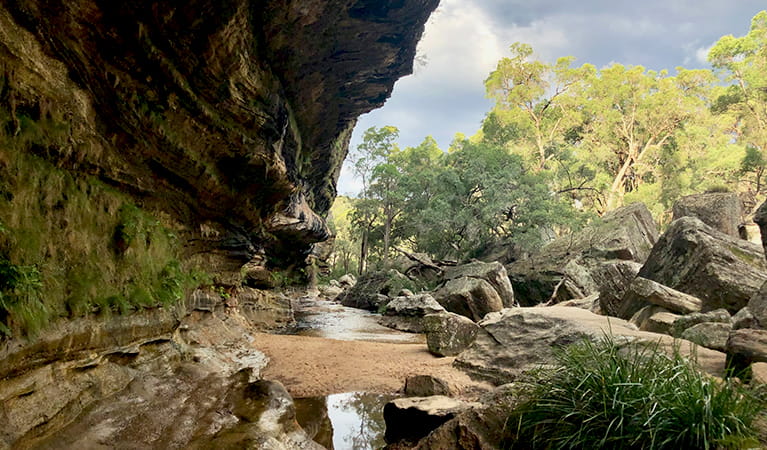Goulburn River National Park
Overview
With its forest and riverside setting, the Goulburn River National Park, near Mudgee, offers lots of opportunity for swimming, fishing, hiking and camping.
Read more about Goulburn River National Park
Camping opportunities don’t come any more spectacular than at Goulburn River National Park. The park stretches along 90km of the river, and its wide, sandy banks and forest landscape offer easy walking and good swimming – particularly in summer – as well as some amazing birdwatching. You won’t need your binoculars to spot the emus, but they’ll be handy for taking a closer look at species like the turquoise parrot. When you’re not birdwatching, keep an eye out for eastern grey kangaroos, red-necked wallabies and wombats, which are also common in this area.
It's an area of significant Aboriginal heritage too. With more than 300 known sites, located mostly along the river, the area is very important to the local Wiradjuri Aboriginal people. If you’re looking for a picturesque place to pitch a tent, get away from it all at either of two campgrounds, both situated on the banks of Goulburn River and surrounded by shady trees.
Local alerts
For the latest updates on fires, closures and other alerts in this area, see https://www.nationalparks.nsw.gov.au/visit-a-park/parks/goulburn-river-national-park/local-alerts
Contact
- in the Country NSW region
Goulburn River National Park is always open, but may have to close at times due to poor weather or fire danger.
-
-
Mudgee office
02 6370 9000
Contact hours: Monday to Friday, 9am to 4:30pm. - 27 Inglis Street, Mudgee NSW 2850
-
Email: npws.mudgee@environment.nsw.gov.au
-
Mudgee office
Visitor info
All the practical information you need to know about Goulburn River National Park.
Map
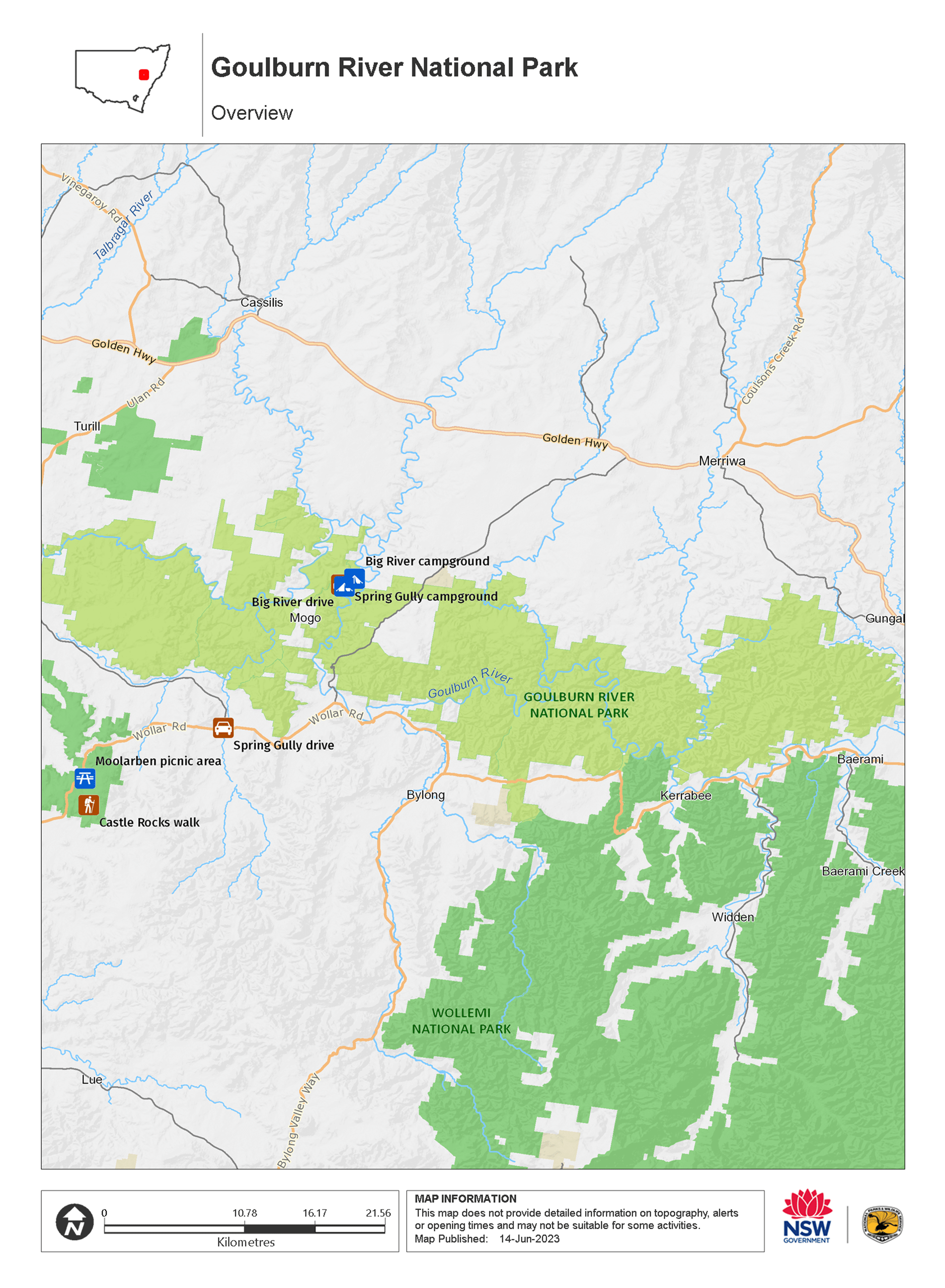
Map legend

Getting there and parking
Get driving directions
Goulburn River National Park is accessible from a number of towns in the area.
- From Mudgee, follow Wollar Road
- From Merriwa, follow Ringwood Road
- From Denman, go along the Denman to Wollar Road – it follows long stretches of the Goulburn River.
Best times to visit
There are lots of great things waiting for you in Goulburn River National Park. Here are some of the highlights.
Autumn
Is there anything more relaxing than sitting around the campfire with family and friends? Autumn is a great time of year to visit Spring Gully campground.
Spring
With the many natives blooming – callistemons, acacias and eucalypts among them – this is the best time to observe the plant and wildlife the park attracts.
Summer
With the temperatures at their warmest, head to the river for swimming and liloing.
Weather, temperature and rainfall
Summer temperature
Average
15°C and 30°C
Highest recorded
40.3°C
Winter temperature
Average
3°C and 17°C
Lowest recorded
–6.7°C
Rainfall
Wettest month
January
Driest month
May
The area’s highest recorded rainfall in one day
186.7mm
Facilities
Toilets
Picnic tables
Barbecue facilities
Maps and downloads
Prohibited
Pets
Pets and domestic animals (other than certified assistance animals) are not permitted. Find out which regional parks allow dog walking and see the pets in parks policy for more information.
Smoking
NSW national parks are no smoking areas.
Nearby towns
Merriwa (29 km)
Merriwa is a unique and friendly rural town nestled in the Upper Hunter Valley. Situated on the Golden Highway, Merriwa is the ideal place for a stopover, as it is centrally located. In just two hours you can reach Mudgee, Dubbo, Newcastle and Tamworth.
Gulgong (52 km)
Founded in the heady days of the Australian gold rush, Gulgong has approximately 130 buildings with National Trust classification. Take a self-guided walking tour of the town's historic sites.
Mudgee (54 km)
Set in the Cudgegong River valley in Central West NSW, Mudgee is a charming historic town and a popular destination for wine enthusiasts keen to sample its award-winning reds and whites. From its many wineries and national parks to markets, festivals and activities for the kids, Mudgee has much to offer.
Learn more
Goulburn River National Park is a special place. Here are just some of the reasons why:
Wild about the park
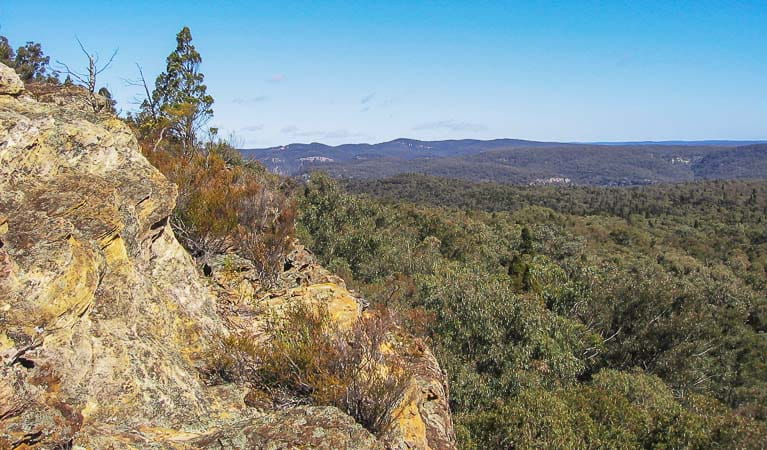
With its location along the river, surrounded by rural holdings, Goulburn River is rich in plant and wildlife. Kangaroos, wallabies and wallaroos are often seen grazing on the riverbanks. A rich variety of plant life - eucalypts, river oak, grevilleas and callistemon (more commonly called bottlebrush) - provides habitats for many birds, including glossy black cockatoos and lyrebirds.
- Big River drive Big River drive leads to Big River campground in Goulburn River National Park. Get in your car for fishing, swimming and camping.
- Spring Gully drive The picturesque Spring Gully drive takes you through lush forest. At Spring Gully campground, you can enjoy a swim, fishing and birdwatching.
Forest landscape
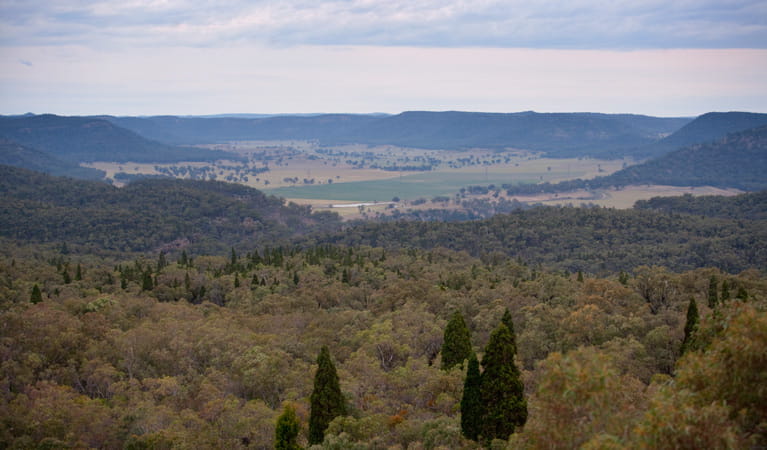
The park, covering over 70,000ha, was established in 1983 following the decision that the land was precious, both environmentally and culturally, especially for the traditional Aboriginal owners. Visiting the park today, you'll admire the sheer magnificence of Goulburn River National Park, due to its preservation as a forest landscape, much of which is surrounded by pastoral land.
- Big River drive Big River drive leads to Big River campground in Goulburn River National Park. Get in your car for fishing, swimming and camping.
- Spring Gully drive The picturesque Spring Gully drive takes you through lush forest. At Spring Gully campground, you can enjoy a swim, fishing and birdwatching.
- The Drip walking track The Drip walking track, in Goulburn River State Conservation Area, meanders beside Goulburn River to The Drip, or 'the Great Dripping Wall’. Rain water trickling through the porous rock wall makes it a cool oasis.
Action aplenty
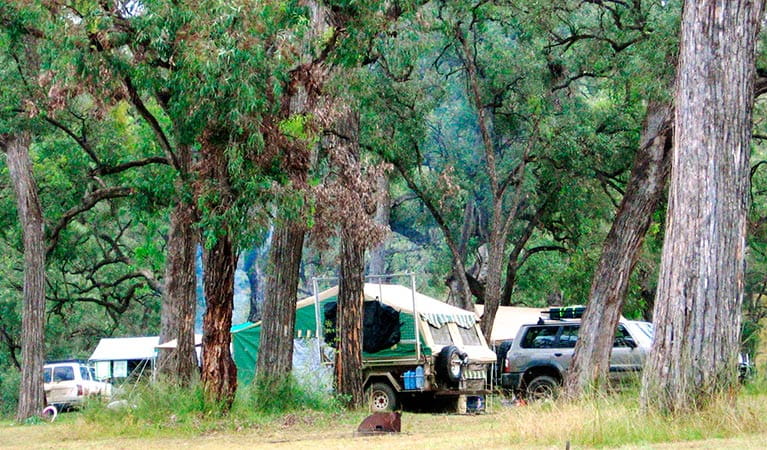
Along the Goulburn River, there are plenty of outdoor pursuits to keep you busy. The river is usually shallow but offers natural pools that are suitable for swimming. After rain, its gentle flow makes canoeing and liloing possible. There are lots of walking opportunities in Goulburn River National Park, like Lees Pinch lookout track or the marked fire trails, which can be explored on foot or on a mountain bike.
- Spring Gully drive The picturesque Spring Gully drive takes you through lush forest. At Spring Gully campground, you can enjoy a swim, fishing and birdwatching.
Aboriginal echoes
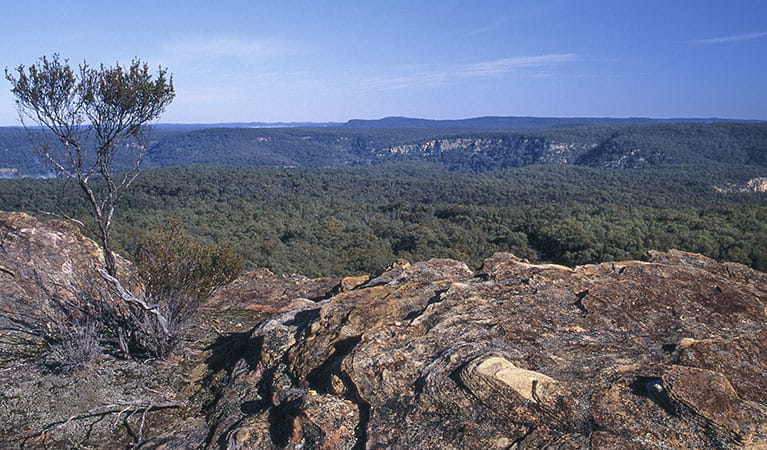
For many thousands of years before European settlement, the river valley that runs through Goulburn River National Park was an important trading route between the Aboriginal people who resided on the coast, and those who lived on the western plains. The area was traditionally occupied by the people of the Wiradjuri, Gamileroi and Wonnarua Clans, and today more than 300 known Aboriginal sites remain within the park, mainly along the river.
- Aboriginal cultural tours of Wiradjuri Country Journey through the Australian bush on a guided tour of Wiradjuri Country with Milan Dhiiyaan. Learn about Aboriginal culture, share in a smoking ceremony and find local bush tucker in Goulburn River National Park.
- The Drip walking track The Drip walking track, in Goulburn River State Conservation Area, meanders beside Goulburn River to The Drip, or 'the Great Dripping Wall’. Rain water trickling through the porous rock wall makes it a cool oasis.
Education resources (1)
What we're doing
Goulburn River National Park has management strategies in place to protect and conserve the values of this park. Visit the OEH website for detailed park and fire management documents.

